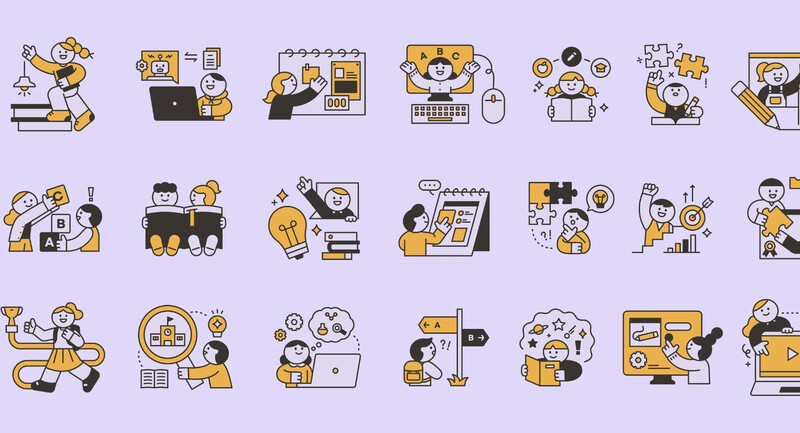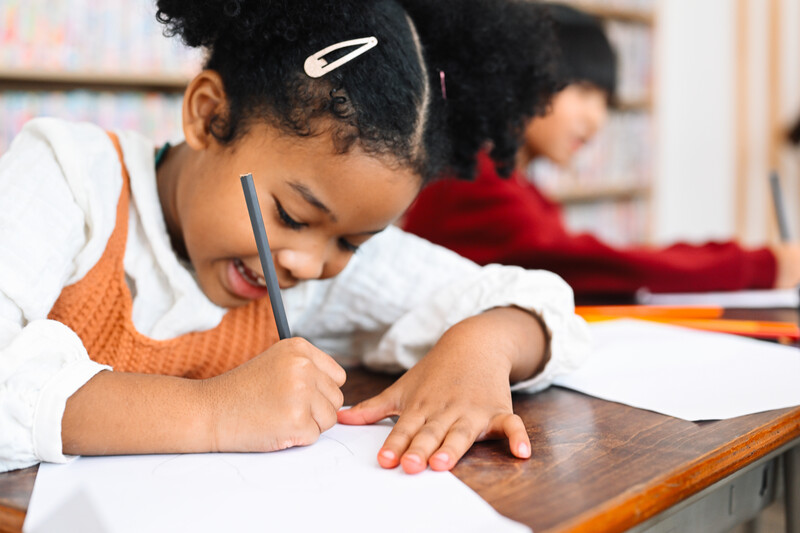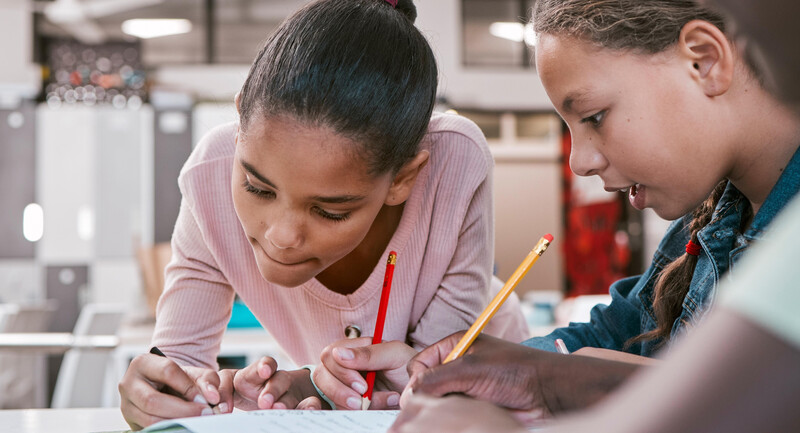A recent Twitter exchange between two teachers forced us to confront some common challenges with feedback.
One educator asked, "Has there ever been anything more disproportionate than the amount of hours put into marking vs. the impact that marking has on individuals?"
The second (tweeted by @Ms_KMP) replied, "I carried out an experiment. Last year I gave individual feedback on an online homework [assignment]. I gave each student a secret code word (e.g., John Smith would be "Jumping Snake") and the message to see me with the code word to get a prize." The disheartening result? "I gave out one bag of Haribo in a class of 30."
As teachers, we spend tremendous amounts of time giving students feedback and grades. Our efforts fill weekends, late nights, and planning periods. The time we spend correcting student misconceptions, engaging with their thoughts, and coaching them toward deeper intellectual work is often deeply intertwined with our identity as educators. We may even see a direct link between how much individual feedback we give students and how much we care for them.
The effort we put into giving feedback matters—as does caring for our students, of course. However, if mistaken and unexamined assumptions inform our practices, we won't impact student learning in the ways we hope. So what misconceptions prevent us from giving feedback effectively—in a way that matters to students? How might we give feedback better, and what education research can we rely upon?
In our work as teachers and teacher leaders in secondary schools, we've found four durable misconceptions about feedback that, in turn, suggest alternate moves teachers can make that are grounded in the research literature (Dickson & Housiaux, 2021). In considering how to best give feedback, we should keep in mind this definition from Wiggins (2012): "Feedback is information about how we are doing that guides our efforts to reach a goal."
Misconception #1: The harder a teacher works, the more a student learns.
Educators are familiar with the adage, attributed to John Dewey, that students learn not from experience, but from reflecting on experience. The same principle applies to feedback. Students don't learn from the time and effort we put into giving them feedback; they learn from reflecting on that feedback, engaging with it, and making meaning with it (Wiggins, 2012). Put differently, students learn from our comments if and only if they do significant intellectual work in dialogue with our feedback.
Students learn from our comments if and only if they do significant intellectual work in dialogue with our feedback.
The implications are clear: When we give feedback to students, our work is only half done. We need to design regular opportunities for students to reflect on our feedback, coaching them in how to do so, to ensure such reflection becomes a durable habit (Brookhart, 2017). Without this instruction, students may not know what to do with the feedback we give them, or how to learn from it. Teachers should return assignments with enough time remaining in class for students to read their feedback, respond to it, and make a plan for their learning and growth. These reflections can be the basis for subsequent teacher-student conferences.
Wiliam (2018) articulates the central principle that feedback should cause thinking. Feedback in the form of questions can cause thinking, especially when we provide an opportunity for students to respond to our inquiries and reflect on their learning. Students can also respond to our feedback by categorizing it: what they did well, what they need to do better, and what they can do next time. When we help students engage with our feedback and ask them to refer back to it in the future, we make it more likely that they'll learn from it—and not make the same mistakes on subsequent assignments.
Misconception #2: Feedback is objective and experienced the same way by all students.
The second misunderstanding is subtler. It's the belief that feedback is objective, and that the same words will be experienced in the same way by all students. Teachers inhabit multiple personal and professional identities in the classroom in terms of race, gender, age, and other identity markers. So do our students. These identities impact the ways in which students receive our feedback. It follows that if we've created a positive environment and built rapport with students, then they will be more likely to see our feedback as supporting their learning and growth—and not as a personal attack.
Teaching is a deeply relational endeavor that requires trusting relationships. With trust in place, teachers can become "warm demanders," building upon this emotional foundation to hold students to high standards and support them in their productive struggles (Hammond, 2015; Kleinfeld, 1975).
The balance between trust and effective communication is especially important when teachers support students who may have good reasons not to trust their school environment. In one important study, Yaeger and colleagues (2014) describe an intervention in which white teachers learned to give one sentence of feedback that had a significant positive impact on Black students: "I'm giving you these comments because I have very high expectations and I know you can meet them." We believe framing feedback in this way is effective because it implies to students that teachers see them as individuals, not solely as members of a group that's subject to stereotype threat.
By articulating the reason for their comments—high standards for the course and students as opposed to personal criticism—and expressing belief that the student can meet those high standards, these teachers offered feedback in a powerful way. Interestingly, these effects were stronger for Black students than white ones in the study and were strongest for Black students who initially had low trust in their environment. Compared to Black students in the control group that received no intervention, Black learners who heard this one sentence revised their work more and achieved higher grades on the task tied to the feedback. The implications of this study are significant: Giving students a sense of belonging and our belief that they can meet high expectations can be deeply transformative.
When teachers give too much feedback on a student assignment, they run the risk of making two mistakes. First, the sheer volume of their feedback might overwhelm students, who won't be able to discern which feedback is most essential (Hattie & Timperley, 2007). A student's working memory can be quickly overtaxed by the many complex cognitive tasks required to read and interpret all the feedback (including deciphering a teacher's handwriting!). When teachers comment on a range of different errors instead of focusing their efforts more strategically, they may give students the mistaken impression that comma splices are of equal significance to identifying the causes of the Civil War. Teachers who design assignments with clear, focused learning goals and then provide targeted feedback in these areas help students understand how to prioritize their learning and thinking.
Teachers also err when their feedback focuses too much on just evaluating completed work, rather than providing guidance about how to improve future work. Wiliam (2016) asserts, "The main purpose of feedback is to improve the student's ability to perform tasks he or she has not yet attempted" (p. 2). Merely focusing on the past will not, in and of itself, help students learn to apply lessons from past work more effectively in the future. Asking students to generate their own focus areas for improvement on subsequent assignments is one way to encourage self-reflection and draw students' attention to their ongoing learning and growth.
A legendary English teacher at Philips Academy used to comment on student essays in crayon. When bemused colleagues asked why, he replied that the crayon required him to write in large letters while prioritizing only a few things. The limitations imposed by using a crayon prevented him from haphazardly writing too much feedback. Even if we don't go to such lengths ourselves, this example illustrates the importance of a teacher's self-restraint in cultivating students' learning.
Misconception #4: Grades are feedback.
Grades and feedback are different. Students can learn from the feedback we give them, but it's much harder to learn from a grade alone (Guskey, 2019). Guskey's research points to the importance of students receiving grades and feedback on assignments. However, many teachers have had the depressing experience of dedicating significant time to responding to students' work on an assignment only to have students scan quickly for their grade, ignore the written feedback, and immediately engage in a comparative conversation about their grade with a classmate. How might we reexamine the entrenched habit of giving students a grade and feedback at the same time?
Postponing the grade is a straightforward, powerful intervention. Teachers can wait to give students their grades until students have spent sufficient time reading and reflecting on their feedback (Kuepper-Tetzel & Gardner, 2021). Doing so removes the understandable temptation for students to search immediately for the grade and then read their feedback through the lens of their score. This approach asks teachers to dedicate some of their limited instructional time–in the classroom or as a homework assignment—to having students read and perhaps respond to the feedback they received. While such an instructional choice can seem difficult, Wiggins (2012) reminds us that "less teaching plus more feedback is the key to achieving greater learning."
Bringing It All Together
Teachers aspire to communicate clearly and create environments where all students can trust us, learn, and thrive. However, our feedback practices don't always align with these aspirations. More than that, these four misconceptions all hint at a more fundamental one: the notion that students know what to do with the comments we give them. How do we know this? Have we ever asked students what they do with the feedback they receive, whether from us, their peers, or themselves?
Postponing the Grade
To remove the temptation for students to focus on a grade, teachers can wait to give them out until students have first spent time reading and reflecting on their feedback.
Giving feedback is an invitation to intentionality. With greater pedagogical clarity, we can significantly increase student learning, and do so in ways that help students be more active, thoughtful participants in their own learning. We can conceive of ourselves and our role in a new way—one where we measure our care for students not in terms of the volume of feedback we provide, but in terms of how much time and guidance we give students to reflect on it.









